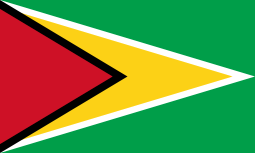Guyana (1966–1970)
Guyana was a predecessor to the modern-day Republic of Guyana and an independent state that existed between 1966 and 1970.
Guyana | |||||||||
|---|---|---|---|---|---|---|---|---|---|
| 1966–1970 | |||||||||
Motto: "One people, one nation, one destiny" | |||||||||
.svg.png) | |||||||||
| Capital | Georgetown | ||||||||
| Government | Constitutional monarchy | ||||||||
| Queen | |||||||||
• 1966–1970 | Elizabeth II | ||||||||
| Governor-General | |||||||||
• 1966 | Richard Luyt | ||||||||
• 1966–1969 | David Rose | ||||||||
• 1969–1970 | Edward Luckhoo | ||||||||
| Prime Minister | |||||||||
• 1966–1970 | Forbes Burnham | ||||||||
| Historical era | Cold War | ||||||||
• Independence | 26 May 1966 | ||||||||
• Republic | 23 February 1970 | ||||||||
| Currency | Guyanese dollar | ||||||||
| ISO 3166 code | GY | ||||||||
| |||||||||
Part of a series on the |
||||||||||||||
|---|---|---|---|---|---|---|---|---|---|---|---|---|---|---|
| History of Guyana | ||||||||||||||
 | ||||||||||||||
|
||||||||||||||
|
||||||||||||||
|
| ||||||||||||||
British rule ended on 26 May 1966, when Guyana was given independence from the United Kingdom by the Guyana Independence Act 1966,[1] which transformed British Guiana into an independent Commonwealth realm or dominion, a sovereign constitutional monarchy with Elizabeth II, as Queen of Guyana. The monarch's constitutional roles were mostly delegated to the Governor-General of Guyana. The following governors-general held office:
- Sir Richard Luyt (26 May 1966 – 16 December 1966)
- Sir David Rose (16 December 1966 – 10 November 1969)
- Sir Edward Luckhoo (10 November 1969 – 1 July 1970)
Elizabeth II did not reside in or visit Guyana during the time she was Queen of Guyana.
The Republic of Guyana came into existence on 23 February 1970,[2][3] when Guyana became a republic within the Commonwealth.
Forbes Burnham held office as prime minister (and head of government) of Guyana during this period. Following the abolition of the monarchy, former Governor-General Sir Edward Luckhoo provisionally became the first President of Guyana.
References
- "Guyana Independence Act 1966". Legislation.gov.uk. Retrieved 26 May 2013.
- "Guyana Republic Act 1970". Legislation.gov.uk. Retrieved 26 May 2013.
- "Guyana Republic Bill". TheyWorkForYou.com. Retrieved 26 May 2013.
